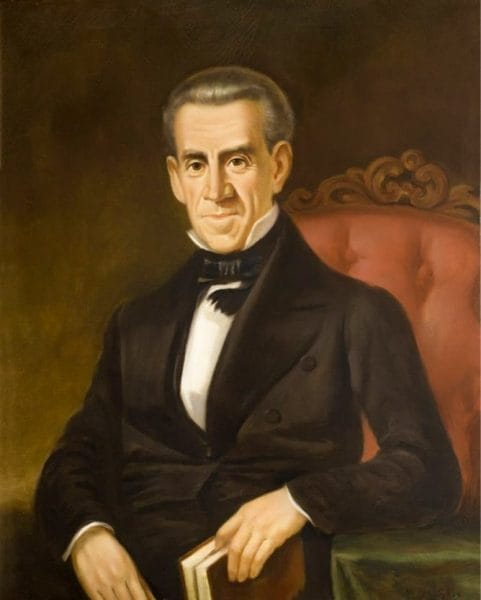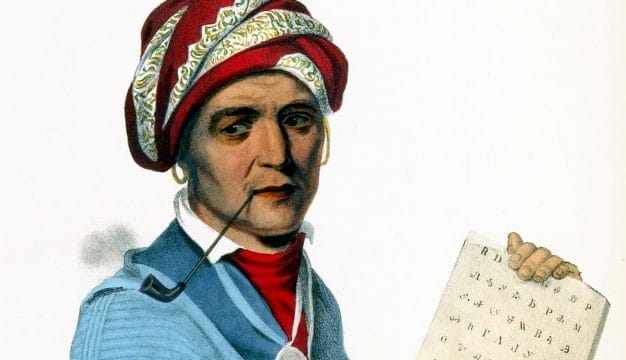Treaty of Cusseta (1832)
The Treaty of Cusseta was an agreement between the U.S. government and the Creek Nation in which the Creeks ceded the remainder of their land east of the Mississippi River, all of which was located in east Alabama. The treaty, also known as the Third Treaty of Washington or more formally as the Treaty with the Creeks, 1832, followed the passage of state and federal laws aimed at gaining control over Native Americans and their land in the South and removing them west of the Mississippi River.
In the late 1820s, Alabama lawmakers enacted three laws, called “extension laws,” that extended the state’s jurisdiction over several tracts of Creek territory in the state. They also passed another law that forbade the Creeks from hunting, fishing, and trapping within the state, which essentially limited them to farming as a livelihood. These and similar laws in other states were supported by Pres. Andrew Jackson, who hoped that the Creeks would either become citizens of the United States and accept individual homesteads or remove themselves westward. In May 1830, the federal Indian Removal Act was signed into law, giving the president the authority to exchange lands west of the Mississippi River for Indian lands in the East. Then, in January 1832, the Alabama legislature passed another “extension law” that extended the civil and criminal jurisdiction of the state over all Creek and Cherokee territory within the state. It forbade Indians from passing laws contrary to state law and from meeting in council, thereby undermining the authority of tribal leaders. The law led to new roads being cut through Creek land and more illegal squatting by whites that had begun in earnest after the establishment of the Federal Road approximately 25 years earlier. In addition, it created conflict between the federal government, which had pledged to protect Native American sovereignty, and Alabama officials, who desired the Creek land for settlement. Alabama lawmakers still resented the fact that three million acres ceded to the United States in the 1825 Treaty of Indian Springs had been returned to the Creeks in the Second Treaty of Washington (1826).
 Opothle Yoholo
In consequence, Jackson invited Creek leaders, including Opothle Yoholo, to Washington to agree upon a treaty that would exchange their remaining land in Alabama (more than five million acres encompassing much of east-central Alabama) for new territory in the West. The treaty was signed March 24. Additional provisions stated that the United States would bear the cost of the Creek relocation west and would provide allotments of 320 acres to each orphan or head of family and 640 acres to each tribal chief and to all town headmen who chose to remain in Alabama. The Creek delegation, however, had pushed for larger and more numerous allotments. Of the five million acres, more than two million were later surveyed and reserved for those Creeks who wanted to stay.
Opothle Yoholo
In consequence, Jackson invited Creek leaders, including Opothle Yoholo, to Washington to agree upon a treaty that would exchange their remaining land in Alabama (more than five million acres encompassing much of east-central Alabama) for new territory in the West. The treaty was signed March 24. Additional provisions stated that the United States would bear the cost of the Creek relocation west and would provide allotments of 320 acres to each orphan or head of family and 640 acres to each tribal chief and to all town headmen who chose to remain in Alabama. The Creek delegation, however, had pushed for larger and more numerous allotments. Of the five million acres, more than two million were later surveyed and reserved for those Creeks who wanted to stay.
The United States agreed to pay $100,000 at the time of the treaty’s signing and annuities of $12,000 annually for five years and $10,000 annually for 15 years. The treaty provided compensation for improvements made to properties and for ferries, bridges, and causeways, at the insistence of the Creek delegates. The accord would make available funds for education and for rifles, ammunition, and other hunting accessories for each emigrating Creek warrior, provided blacksmiths, and established an annual allocation of iron and steel for 20 years.
 Clement Comer Clay, 1835
The treaty was one of many concluded during Jackson’s presidency as part of his plan to relocate Native Americans to Indian Territory, which remains a controversial aspect of his legacy. It was signed by Lewis Cass, the secretary of war and an instrumental figure in implementing Jackson’s policy of Indian removal. Among the Alabamians present at the signing was U.S. Representative Clement Comer Clay, who, when he was speaker of the Alabama House of Representatives, had pushed for the extension laws and had supported the rights of white squatters who had illegally settled on Creek land. Also present was Alabama senator William Rufus King, then chair of the U.S. Senate Committee on Public Lands, who backed Jackson’s land policies and worked to open public lands to settlement.
Clement Comer Clay, 1835
The treaty was one of many concluded during Jackson’s presidency as part of his plan to relocate Native Americans to Indian Territory, which remains a controversial aspect of his legacy. It was signed by Lewis Cass, the secretary of war and an instrumental figure in implementing Jackson’s policy of Indian removal. Among the Alabamians present at the signing was U.S. Representative Clement Comer Clay, who, when he was speaker of the Alabama House of Representatives, had pushed for the extension laws and had supported the rights of white squatters who had illegally settled on Creek land. Also present was Alabama senator William Rufus King, then chair of the U.S. Senate Committee on Public Lands, who backed Jackson’s land policies and worked to open public lands to settlement.
According to the Senate Executive Journal, members of the Senate Committee on Indian Affairs expressed concern when the treaty was reported out of the committee that any Creeks who signed the treaty should be duly authorized and delegated to do so by the Creek Nation. This sentiment was understandable given the problems encountered with the nullified 1825 Treaty of Indian Springs and its replacement with the Second Treaty of Washington.
The federal government quickly surveyed the land and designated the allotments, drew up regulations, and appointed agents to oversee land sale agreements between Creeks and whites. Neither the treaty nor the ensuing process ended the tension between the Creeks and Alabamians or between Alabama and the federal government. Alabama created eight new counties from the land, a move that enticed land-hungry settlers who illegally squatted before the allotment process was completed and who, afterward, bought up allotments at below-market prices from those Creeks who chose to stay.
The federal government did attempt to keep out or evict white squatters. During the summer of 1832 in Russell County, a white settler was killed by a federal soldier, who was indicted but fled and was never tried. The incident angered Alabama lawmakers over the perceived federal encroachment on the state’s rights and would fester for years, while at the same time lessening support for Jackson in the state. Soon, more frequent conflicts between the whites and Creeks would lead to the Second Creek War in 1836 and additional forced removals west.
Further Reading
- Green, Michael D. The Politics of Indian Removal: Creek Government and Society in Crisis. Lincoln: University of Nebraska Press, 1982.
- Harmon, George Dewey. Sixty Years of Indian Affairs: Political, Economic, and Diplomatic 1789-1850. Chapel Hill: University of North Carolina Press, 1941.
- Kappler, Charles J., ed. Indian Affairs: Laws and Treaties. 7 vols. Washington, D.C.: U.S. Government Printing Office, 1904.



